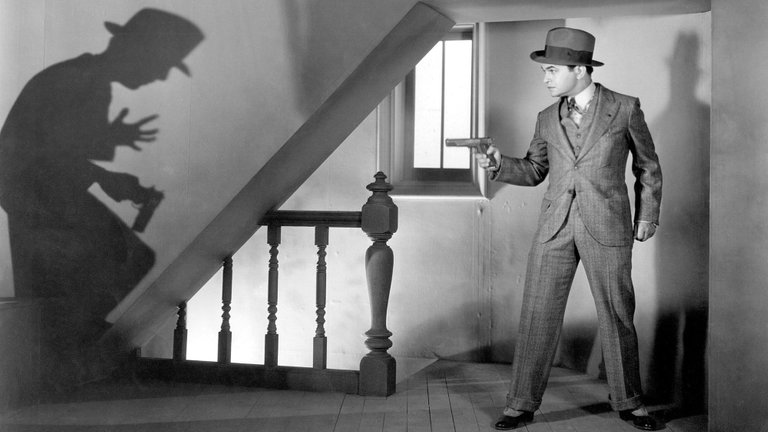Film Review: Little Caesar (1931)

According to Martin Scorsese, American cinema brought three of their very own genres to the world – western, musical and gangster film. The latter two were properly developed with a arrival of sound era – musicals because of technology, while gangster films because arrival of sound technology coincided with latter stages of Prohibition and early years of Great Depression, times when American audience became increasingly fascinated with violent and exciting world of organised crime in their big city. One of the first films to exploit such trends was 1931 film Little Caesar, directed by Mervyn LeRoy and often considered to be “the grandfather of modern gangster genre”.
The script is based on the 1929 novel by W. R. Burnett, writer who had found inspiration in Chicago during the times where powerful gang of bootleggers led by Al Capone controlled most of the city. Burnett also wrote the script. The plot begins when duo of small-time criminals – Caesar Enrico “Rico” Bandello (played by Edward G. Robinson) and Joe Massara (played by Douglas Fairbanks Jr.) - arrive to the big city to seek fortune. They join the gang led by Sam Vettori (played by Stanley Fields) and Rico, through his bravery and resourcefulness rises through the ranks, ultimately replaces Vettori as boss and ultimately intimidates his peers to become “boss of bosses”. His ruthlessness and ability to commit violence, however, doesn’t sit well with Joe. When Joe meets actress Olga Stasoff (played by Glenda Farrell) and becomes engaged to her, he decides to quit the life of crime and instead restart his original career of professional dancer. Rico is infuriated with this decision and he threatens his friend. Olga reacts by contacting Lieutenant Flaherty (played by Thomas Flaherty), policeman determined to bring “Little Caesar” down and this starts the chain of events that would lead to Rico’s violent end.
Like many of the earliest sound films, Little Caesar gives away limitations new technology. One example can be found in use of intertitles instead of expository dialogues or more conventional forms of film narration. Another is in the particular scenes being set in such way to strategically hide microphones during the shooting. Despite this, Mervyn LeRoy, experienced director who would have prolific career in next decades, handles the plot efficiently, keeping the story simple and running time at 79 minutes. What elevates the film, however, is brilliant performance of Edward G. Robinson, actor whose role of Rico actually wasn’t devised as main, but who made Little Caesar hit due to the strength of his talent. Robinson obviously based his character on Al Capone, who was at the time of production, still running bootlegging empire at Chicago. Yet Rico at the same time looks original – someone from the bottom of the society who tries and almost works his way to the top on the sheer power of his personality. He also plays Rico as deeply flawed character who ultimately fails not only because of his violent ways turn counterproductive, but also because he spares the life of his friend out of sentimental attachment at most inopportune moment. That scene many years later led critics and scholars to debate whether Rico’s character was homosexual or not. The audience, however, didn’t care much of such nuances and embraced the film. Robinson easily outshone anyone else in the film, including his partner Douglas Fairbanks Jr., son of silent era superstar and screen idol in his own right. Due to role in Little Caesar Robinson became instant star, but was often typecast in the role of gangsters and his performance was often object of parody in later films, including Warner Bros. cartoons.
Little Caesar was produced by First National Pictures, sister studio of Warner Bros., that would in next decade become specialised for gangster films. With infamous MPAA Production Code still not being properly enforced, there was much more creative freedom in Hollywood in early 1930s and some of it can be seen in early gangster films. Little Caesar had scenes of violence that were quite tame even for early 1930s standards, but this nevertheless cause censorship cuts in many markets and debates whether Hollywood films might give wrong message to impressionable youths. Yet, despite all that, many other studios and many other cinema industries soon began to experiment with various forms, stories and characters of the genre, thus cementing Little Caesar as one of the most important genre films in history of cinema.
RATING: 7/10 (+++)
Blog in Croatian https://draxblog.com
Blog in English https://draxreview.wordpress.com/
Leofinance blog https://leofinance.io/@drax.leo
Unstoppable Domains: https://unstoppabledomains.com/?ref=3fc23fc42c1b417
Hiveonboard: https://hiveonboard.com?ref=drax
Bitcoin Lightning HIVE donations: https://v4v.app/v1/lnurlp/qrcode/drax
Rising Star game: https://www.risingstargame.com?referrer=drax
1Inch: https://1inch.exchange/#/r/0x83823d8CCB74F828148258BB4457642124b1328e
BTC donations: 1EWxiMiP6iiG9rger3NuUSd6HByaxQWafG
ETH donations: 0xB305F144323b99e6f8b1d66f5D7DE78B498C32A7

Espero que las personas que lean este post, pero sobre todo que opinen en los comentarios, tengan en cuenta las técnicas de cinematografía, la dirección de fotografía y el trabajo del montaje. O sea, esto es arte puro. Así de simple. Gracias por hacer una reseña histórica de esta película fantástica. Un abrazo, @drax
Edward G. Robinson was one of the all time great actors in film, and his performance in this film is no exception. Great wrtie-up, thanks for sharing.
!PIZZA
Posted using CineTV
PIZZA Holders sent $PIZZA tips in this post's comments:
@thunderjack(2/5) tipped @drax (x1)
Join us in Discord!
https://twitter.com/21393347/status/1637198575170994176
The rewards earned on this comment will go directly to the people( @drax ) sharing the post on Twitter as long as they are registered with @poshtoken. Sign up at https://hiveposh.com.